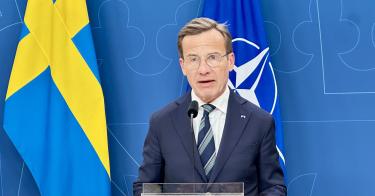Sweden’s accession to NATO in March 2024 was historic. Stockholm shifted away from a position of neutrality it had held for more than two centuries.
Sweden is one of the more impressive defense spenders in NATO and recently announced a defense budget of 2.8% of gross domestic product for 2026, expecting to reach 3.1% by 2028. Even before all NATO countries, except Spain, agreed to increase their core defense spending to 3.5% by 2035 in The Hague this summer, Sweden had announced plans to reach the new standard ahead of time.
Sweden’s defense industrial base is one of the most impressive in NATO, and it’s also one of the major European producers of fighter jets. The Gripen, produced by the Swedish defense company Saab, is one of the most formidable European fighter jets, comparable to the Eurofighter Typhoon and Dassault Rafale. The Gripen is leased by multiple countries, including Czechia, which recently extended its lease of 12 of the fighter jets until 2035. Gripen fighter jets recently saw combat for the first time and performed admirably as the Royal Thai Air Force employed them in response to Cambodian rocket attacks.
>>> The NATO Accession of Finland and Sweden: A Strategic Advantage for the Alliance and the U.S.
In addition to Gripens, Sweden builds its own missile systems, ground combat systems and attack submarines.
Sweden’s military force contributes to collective deterrence in two regions in particular: the Baltic and the Arctic.
Sweden owns the island of Gotland in the Baltic Sea, which, depending on how heavily defended, could either serve as a liability or an asset in deterring Russia.
Military leaders have repeatedly emphasized the strategic importance of Gotland as a potential target in a hypothetical war with Russia. During the Cold War, there was concern about what planners called the “Gotland Gambit,” in which Soviet forces might seize Gotland to test NATO’s reaction to violating the sovereignty of a friendly and aligned but neutral European nation.
Sweden has undertaken significant investments into modernizing its air defense systems and its fleet of fighter jets to maintain a military advantage in the Baltic. Given these investments and future planned investments, Gotland may soon become far more of an asset than a concern, contributing to the defense of Estonia, Latvia and Lithuania while giving Russian forces in Kaliningrad something to worry about.
>>> Some Cold, Hard Facts About U.S. Arctic Strategy
Sweden is rightly placing a high priority on its contributions to the defense of the Baltic states, the three NATO members most likely to face Russian aggression. In January, a Swedish mechanized infantry battalion joined the Canadian-led multinational brigade in Latvia to contribute to deterrence efforts in the Baltic states.
Sweden regularly participates in joint NATO operations and exercises in the North Sea and Baltic Sea, including NATO’s recent military exercise, the largest since the Cold War: Steadfast Defender 24.
Sweden also plays a vital role in Arctic security, increasing its Arctic warfare units in the Swedish north and expanding its already extensive military cooperation with Finland and Norway.
Sweden has been a welcome addition to NATO and is a model for other European countries. As America pivots its military posture away from Europe and the Middle East toward the Indo-Pacific, European NATO members must take the lead in providing conventional deterrence on the continent, even as the U.S. continues to offer specific strategic enablers. Luckily, responsible and effective NATO members such as Sweden are stepping up and demonstrating that they take their security seriously and are ready to play a larger role in European security.
This piece originally appeared in The Washington Times




